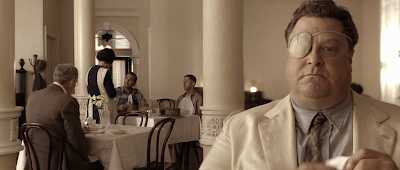 | |
| Polyphemus |
 |
| John Goodman as Big Dan Teague |
In the "Big Dan Teague" arc of the movie, we can identify a few similarities with "Book IX" of The Odyssey when Odysseus encounters the cyclops, Polyphemus. First and most obvious is the physical resemblance between John Goodman's character, Big Dan Teague, and the popular representation of Polyphemus from The Odyssey. In "Book IX", Polyphemus has a minimal description as one of the monstrous "Cyclopes" on the island. From the reading we know that he is a brutish giant with immense strength; and we can infer from the blinding of Polyphemus that he
In the book, and as we've discussed in lecture, Odysseus isn't merely the innocent wanderer who is viciously and unduly attacked by the dreadful giant; instead, Odysseus invades the sacred home of Polyphemus and begins to spoil his possessions, only afterwards invoking the bronze-age tradition of xenia. That isn't to say that the cyclops murder and devour of Odysseus' companions is an appropriate response to his transgressions, but it does allow for a similarity between "Book IX" and the Big Dan arc of the movie. In the movie, Everett and Delmar are escaped convicts that have recently gained a large amount of money from the criminal George Nelson. They are in that way, "unwholesome" when Big Dan Teague seeks them out after noticing them at a restaurant. Also, after Everett and Delmar meet Big Dan, they only follow him to take advantage of a possible money scheme--again, "unwholesome". So when Big Dan later takes the club to their heads, it can't be said that he clubbed two innocent men; rather, two of three bad man got the...wrong end of the stick.
This leads to what I believe the core of the Coen's interpretation of "Book IX", the purely physical and violent overpowering of Odysseus. During most of Odysseus' other trials he is victim to the divine force--e.g. Poseidon, Scylla, Circe, and Calypso. The cyclops only real advantage over Odysseus is his strength. Similarly, in the movie, Big Dan Teague is a monster of a man who only uses his immense strength to conquer Everett and Delmar. It's a simple and common obstacle where the hero is physically overpowered by the villain and has to rely on his guile to outwit his adversary. Indeed, in the book we know that Odysseus tricks Polyphemus into believing he is "Nobody", blinds him, and then steals himself and his men through the entrance of the cave underneath Polyphemus' own sheep; and in the movie, there is the albeit less dramatic scene where Everett drops the burning cross on Big Dan.
--------------------
I like the "wrong end of the stick"! And I would agree, Odysseus has to constantly use his wits to evade being overpowered by sheer force. You note that Everett, Delmar, and Dan Teague are equally unwholesome; I would add that the Coen brothers also realized that Odysseus and the Cyclops share a number of characteristics, brought out in the film by Dan Teague's slick salesmanship & command of the language.
Both of those Cyclops images are disturbing! Something about the beige and the missing eye is unsettling. Band-Aid fleshtones.
Bibliography
Homer. "Book XVI." The Odyssey of Homer. Trans. Richmond Lattimore. New York: Harper & Row, 1967. 240-52. Print.
O Brother, Where Art Thou? Dir. Joel Coen. Prod. Joel Coen and Ethan Coen. Perf. George Clooney, John Turturro, Tim Blake Nelson, and John Goodman. Touchstone Pictures and Universal Pictures, 2001. DVD.
O Brother, Where Art Thou? Dir. Joel Coen. Prod. Joel Coen and Ethan Coen. Perf. George Clooney, John Turturro, Tim Blake Nelson, and John Goodman. Touchstone Pictures and Universal Pictures, 2001. DVD.
No comments:
Post a Comment